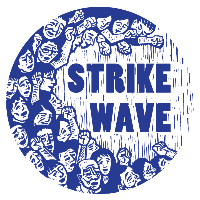Want Unions? There’s (apparently) an app for that.
by Dave Kamper
On issue after issue across the whole spectrum of progressive public policy, a divide is growing between those who believe the present system can, with the right tweaks, be made to work, and those who see the system as rotten to the core, requiring root-and-branch reformation.
The Century Foundation’s new report, “Finding Workers Where They Are: A New Business Model to Rebuild the Labor Movement,” is an example of the former. Its author, Century Foundation President Mark Zuckerman, clearly knows little about the how union organizing works, but this does not stop him from treating labor’s woes as little more than a problem of communication, fixed by some nice digital wizardry.
The Century Foundation positions itself as a friend of unions. Certainly TCF has made important contributions to the debate. But “Finding Workers Where They Are” is not such a piece. It’s not because its message (distilled: unions need better apps) is entirely without merit—there’s more unions can and should do in the digital world. It’s because the report fundamentally misunderstands the nature of labor organizing.
The heart of the report is an analysis of recent union election data from the National Labor Relations Board. That data shows that smaller bargaining units are more likely to vote yes in union elections. From this, Zuckerman draws the conclusion that unions need to find lower-resource ways to organize small workplaces, because that’s where the real growth potential of labor is. Hence the need for an app.
That’s not how it works, and that’s not the real problem. The whole premise of this report is flawed, and had Zuckerman talked to any labor organizers before writing this report, they would have alerted him to this immediately.
Zuckerman has made the mistake of treating the most institutionally-visible part of an organizing campaign, the union election—with secret ballots, formal certifications, and its own scene in Norma Rae—as the most important. It’s not, not even close, but it is precisely the kind of mistake a DC-based think tank immersed in a world of staid institutions would make.
First, huge amounts of organizing today happen without an NLRB election ever occurring. Second, Zuckerman doesn’t demonstrate an understanding of how an NLRB election fits into the cycle of an organizing campaign. For every campaign that makes it to an NLRB election, there are an unknown number that never get that far. The workers aren’t engaged enough, maybe, or the boss’ anti-union campaign is vicious and dirty enough to scare people off. Those campaigns—and I’ve been a part of several—never make the NLRB data.
This would especially be true of small bargaining units. With a group of 15 workers, you really ought to know pretty darned well whether or not you will win. That’s less true of big units. Even if things look doubtful, there’s a strategic argument for rolling the dice on the chance of winning a big unit. 5,000 new members is a lot, and even if you only have a 10% chance of winning, that might be worth it.
None of this is secret knowledge. Mark Zuckerman could have found it out easily with a conversation with literally any organizer I know. But it undermines the whole basis of his argument. The NLRB data do not show that small bargaining units are more likely to want unions than big ones. They show how various organizing strategies and processes mean that elections for smaller units are more likely to be sure things than big ones.
This basic misunderstanding of the nature of union-building carries into the rest of his report. Centering union reformation in the NLRB process ignores all the pre-NLRB, post-NLRB, and non-NLRB paths to unionization, all of which are more important than one institutional moment.
Zuckerman also woefully misunderstands the nature of union-building when he claims that creating digital tools for workers to self-organize would change employer attitudes towards unions:
Some employers may react better to organic efforts by employees to organize a workplace. In union campaigns, some employers use the argument that employees are acting at the behest of outsiders, such as “big labor” or “outside organizers,” who they claim do not have the employees’ interests at heart. Organic organizing makes it clear from the start that the employees are initiating the organizing drive and advocating for better working conditions on their own behalf…
Is the Century Foundation genuinely unaware that nearly all organizing begins with organic efforts by employees? And that, even when outside organizers assist with a campaign, the best campaigns are always run by and centered on the workers in a workplace? And that, no matter who or how an organizing effort begins, the employer always claims the union will be a foreign third party that will get between benevolent bosses and loyal workers? Do they seriously not know this?
This is the problem at the heart of this report, and indeed at the heart of many mainstream Democratic attitudes towards labor unions. It is all about power. Bosses don’t like sharing their power, so they will fight against unions whenever they get the chance. There is no tweak to the process, no rhetorical strategy or logical argument, that will cause bosses to accept the legitimacy of collective action by workers in the workplace. It has always been this way.
Unions most assuredly would benefit from more attention to the digital world in their organizing. But it is nothing less than willful ignorance for The Century Foundation to act like the challenges of labor organizing can be solved by technical tweaks. That is not the world we live in. It is time for supposedly progressive organizations like The Century Foundation to understand that.
Dave Kamper is a labor organizer and writer in Minnesota. He can be reached at dskamper@hotmail.com and followed on Twitter @dskamper

